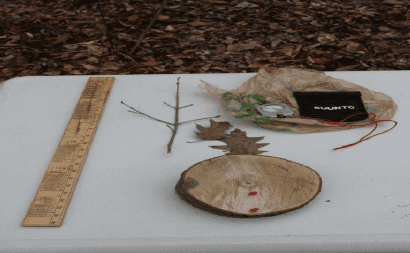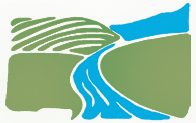 The forestry station will focus on forests as ecosystems in New York State. Students will be expected to have a basic understanding of forested ecosystems, how they function and change over time, their role in a watershed, and why they are valuable resources.
The forestry station will focus on forests as ecosystems in New York State. Students will be expected to have a basic understanding of forested ecosystems, how they function and change over time, their role in a watershed, and why they are valuable resources.
In general, the word forestry means the propagation and management of forest trees for commercial harvest. This include the planting and management of exotic (nonnative) species, the existing native forest, and the genetic improvement of trees for selected characteristics, such as straight and rapid growth.
Forestry also means the scientific study of tree growth, management, and timber production systems. The term forestry probably evokes visions of loggers, tree farms, and large tracts of woodlands.
National forests provide vital ecosystem services, such as habitat for wildlife and native plants, act as water reservoirs and filters, take up carbon dioxide, release oxygen, and regenerate precious soil. In addition to ecosystem services, forests also provide humans with lumber, recreation areas, and aesthetic value. Forests store large amounts of carbon dioxide that might otherwise contribute to global warming, in the form of wood.
In the eastern US, deciduous hardwood forests characterize the dominant forest types. In the western US, coniferous evergreen forests dominate. In the United States, we have several major forest biomes including temperate deciduous forests, sub-tropical mixed forest, temperate mixed forest, temperate coniferous forest and taiga.
Much of the forest area in the west still remains under public ownership, held as either national forest or Bureau of Management land. In the east, however, much of the surviving forests are under private ownership. Founded in 1905 by Gifford Pinchot, the United States Forest Service (part of the US Department of Agriculture) is the single- most important agency with reference to public forest land.
Students should be aware of and knowledgeable about the following: identification of common tree 14 species as well as tree parts and function; basic characteristics of forests and forest structure; forests as ecosystems; a general knowledge of forest history in our region; issues affecting forest health and management including invasive plants, fragmentation and urban sprawl; plant and animal communities that inhabit local forests; and silvicultural practices.
Forestry Outline
I. Tree Physiology and Tree and Shrub Identification
A. Identify parts of tree, including tissue of roots, stem, and leaves
B. by leaves, bark, flower or seed for trees listed in “Know Your Trees” without a key
C. by leaves, bark, flower or seed for uncommon trees using a key
II. Forest Ecology
A. Forest Structure
B. Ecological Concepts and terminology
1) Relationship between soil and forest type
2) Levels of succession
C. Factors influencing tree growth and forest development
1) climate, insects, microorganisms, and wildlife
D. Forest Health
1) Identify common insects and diseases
2) Identify invasive species
III. Sustainable Forest Management
A. Silvicultural Techniques (thinning, single tree or group tree selection, shelterwood, clearcutting, seed tree)
B. Silviculture Systems (clear-cutting , seed tree method, evenaged management, unevenaged management, shelterwood and selection)
C. Silviculture treatments (Planting, thinning, harvesting)
D. Forestry tools and equipment
1) Basal Area
2) Diameter
3) Height
E. Factors influencing management decisions (ecological, financial, social)
IV. Uses of Trees and Woods
A. Community Trees- their values, threats to them and challenges growing them
B. Social and Economic Value
1) Products 2) Watershed protection 3) Wildlife
Forestry Learning Objectives
For successful completion of the forestry section, contestants should be able to:
- Understand tree growth, parts and tissues of a tree, and the life cycle of a tree.
- Identify common tree species from bark, leave or seed without a key, and identify unusual trees and shrubs through the use of a key.
- Know the typical forest structure: canopy, understory and ground layers and crown classes and the common species that are found in each layer.
- Understand forest ecology concepts and factors affecting them, including tree communities, regeneration, competition, and primary and secondary succession.
- Identify the abiotic and biotic factors in a forest ecosystem, and understand how these factors affect tree growth and forest development including the relationship between soil and forest types. Consider factors such as climate, insects, microorganisms, and wildlife.
- Be familiar with and able to identify common and invasive tree pests and diseases. Be able to identify associated control methods.
- Understand silvicultural terms, and be able to explain the uses of the following techniques: thinning, single tree and group tree selection, shelterwood, clearcutting, and seed tree management and high grading.
- Explain the following silviculture systems: clear-cutting , seed tree method, evenaged management, unevenaged management, shelterwood and selection.
- Know how to use forestry tools and equipment in order to measure tree diameter, height and basal area. Know how to use and read a Biltmore stick, grade scale and log chart.
- Understand how forest health and management affect biodiversity, global warming, and forest fragmentation. Understand how economic, social and ecological factors influence forest management decisions.
- Understand the importance and value of trees in urban and community settings, and know the factors affecting their health and survival.
- Understand the economic value of forests and know many of the products they provide to people and society. Understand why trees and forests are important to human health, recreation, wildlife, and watershed quality.Forestry Sample Questions1. What are two of the beneficial functions most tree roots provide a tree?a.Nutrient sublimation and soil stabilization.
b.Water absorption and wildlife habitat.
c.Mechanical support and water absorption.
d.Water absorption and nitrogen fixing in the soil.2. Greater economic return from multiple timber sales is achieved by ?a.Periodic harvesting of trees which are over a specified diameter but, no more often than 10 years apart.
b.Use of a standard contract with every harvest.
c.Thinning out the largest trees, leaving some large and mostly small trees to grow.
d.Determining the stand structure, composition, age, health then developing a management plan.3. Identify by species the trees numbered 1 through 7. Each of the lists below contains 5 tree species. Which list contains only tree species you have just identified?
a.Scotch (Scots) pine, Red oak, Basswood, White ash, Acer saccharinum
b.White ash, Larch, Sugar maple, Shagbark hickory, Quercus rubra
c.White pine, Red cedar, Sugar maple, Red oak, Fraxinus americana
d.Sugar maple, White cedar, White ash, Shagbark hickory, Prunus serotina e.Red maple, Red cedar, White ash, Pitch pine, Quercus rubra4. Which of the individual trees that you identified would be most valuable in terms of mast production for squirrels?
a.1
b.2
c.3
d.45. Measure the tree labeled number 4 for: D.B.H., merchantable saw-log height and, total height. [When you are near the tree, you will notice a line marked on the ground and various distances from the tree are marked along this line. You may use this as needed or not.] The correct results are:
a.18”, 2.5 logs, 75 feet
b.14”, 24 ft., 80 feet
c.24”, 40 ft., 75 feet
d.18”, 2 logs, 32 feet6. Observe and consider the condition, structure, and composition of the woodlot before you. Which statement best characterizes the woodlot?
a.Early successional forest, re-colonizing an old field.
b.Young second growth forest with residual overstory from previous harvest c.Old growth forest in decline with regenerating understory.
d.Mature, fully-stocked overstory with developed hardwood tree understory.8. The insect in the specimen container labeled B is a?
a.Asian long-horned beetle b.White spotted sawyer c.Spruce beetle
d.Hemlock wooly adelgid9. Regenerating shade tolerant species is best done through which of the following cutting practice choices?
a.Crown thinning
b.Single tree selection
c.Clearcutting
d.Thinning from belowForestry References
I. Tree Physiology and Tree and Shrub IdentificationKnow Your Trees, What Tree is it, Silvics Manual 1, Silvics Manual 2, Tree Decay, Stem & Root Anatomy, Tree Biology 1, Tree Biology 2, Physiology of TreesII. Forest EcologyForest Regeneration, Forest Ecology, Forest Succession, Asian Long Horned Beetle, Early Successional Forest Ecosystem, Northeastern Forest Regeneration Handbook, Asian Longhorn Beetle or Whitespotted Sawyer, Forest Tent Caterpillar, Dutch Elm Disease, Beach Bark Disease, Emeral Ash Borer, Spruce Beetle, Sudden Oak Death, Invasive Plants Field Guide, Ecology of Dead Wood, Seceroderis Canker of Northern ConifersIII. Sustainable Forest ManagementHarvesting & Forest Management, Silvicultural Systems, Tree Scale Stick, How Much Lumber in That Tree, Managing Forest for Wildlife & Compatible Uses for WildlifeIV. Uses of Trees and WoodsAdditional Resources:CertificationInsect & DiseaseArmillaria, Asian Longhorn Beetle, A Wanted-Asian Longhorned Beetle of Beech Bank Disease, Identify & Management of Dutch Elm DiseaseGlobal ForestryForest ManagementManagement Plan First Step in Forest, Measuring the Volume with Scale Stick Standing Tree, Selective Cutting, Silvics, Tree Planting & SiteMeasurementTree BiologyUrban ForestryWebsite References

